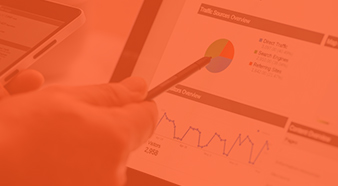Custom Reports are most useful when you have to combine metrics and dimensions that are not included in the standard report layouts, or when you want to simplify an existing report format by removing data that’s not relevant.
Building a tailored custom report in Google Analytics is easy and means quicker access to the information you’re more interested in, with less data overload and easy exporting. It allows you to create, save, and edit reports that present the information you want to see organised in the way you want to see it. A drag and drop interface lets you select the metrics you want and define multiple levels of sub-reports. Once created, they can be exported in the usual way of clicking on the export button on the top of the dashboard and choosing the format in which to export it.
It’s easy to navigate to the custom reports by just clicking on the ‘Custom Reporting’ link in the menu on the left-hand side of the main dashboard. Then choose some of the Analytics data from the left hand side menu that can be classified in two simple ways: Metrics or Dimensions.
A metric is the horizontal column heading(s) in the report that is a quantitative measure of how visitors interact with your site. Metrics are always numerical and include things like page views, time on page and bounce rate (the percent of visitors that leave your site after only 1 page).
A dimension is the vertical row(s) in the report that is a characteristic of a visitor or a page on your website that you can use to organize your metrics. Dimensions are almost always text, such as “new” vs “returning” (visitor type) or “North America” vs “Europe” (region).
You can choose any metric to build your custom report with. You also don’t have to pair them with dimensions, which means there are no restrictions to which metrics you can use. However, when they are paired with dimensions, metrics are subject to certain restrictions.
By using custom reports, it is possible to drilldown to five levels deep into the data or to keep the reports more simplified than the ones displayed on the standard dashboard. So the choice of creating simple or complex reports is entirely yours with the flexible and extremely useful Analytics Custom Reporting Tool.
This article was first published in the August 2009 edition of our monthly newsletter.
To find out more about Google Analytics and how you can use it effectively for your business, please get in touch for an initial, no obligation, discussion. Alternatively, if you are thinking of using website analytics for the first time, or have already started tracking your visitor data, we can provide you with a FREE analytics assessment to give you an idea of the key elements you should be tracking and reviewing to increase the performance of your website.



